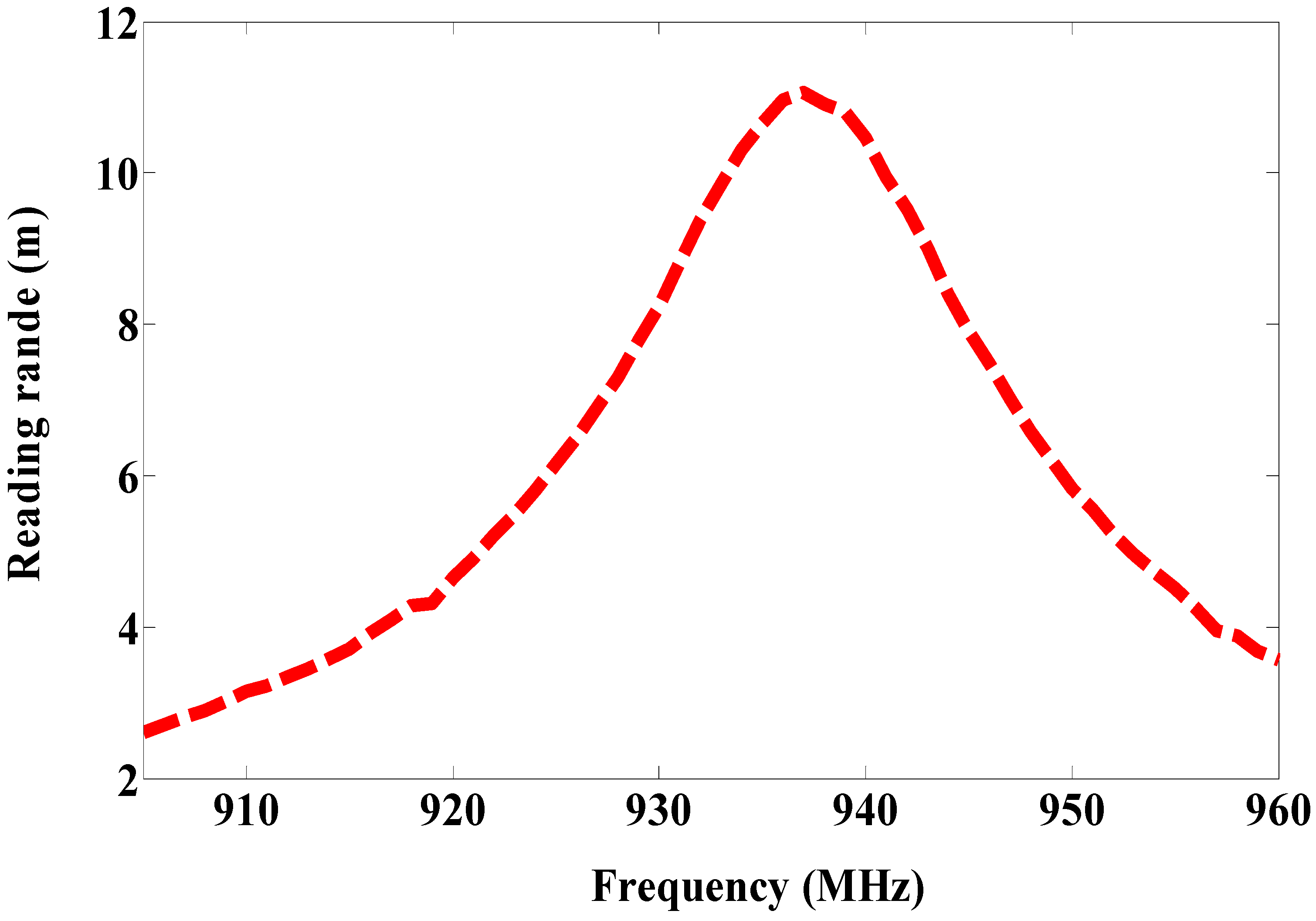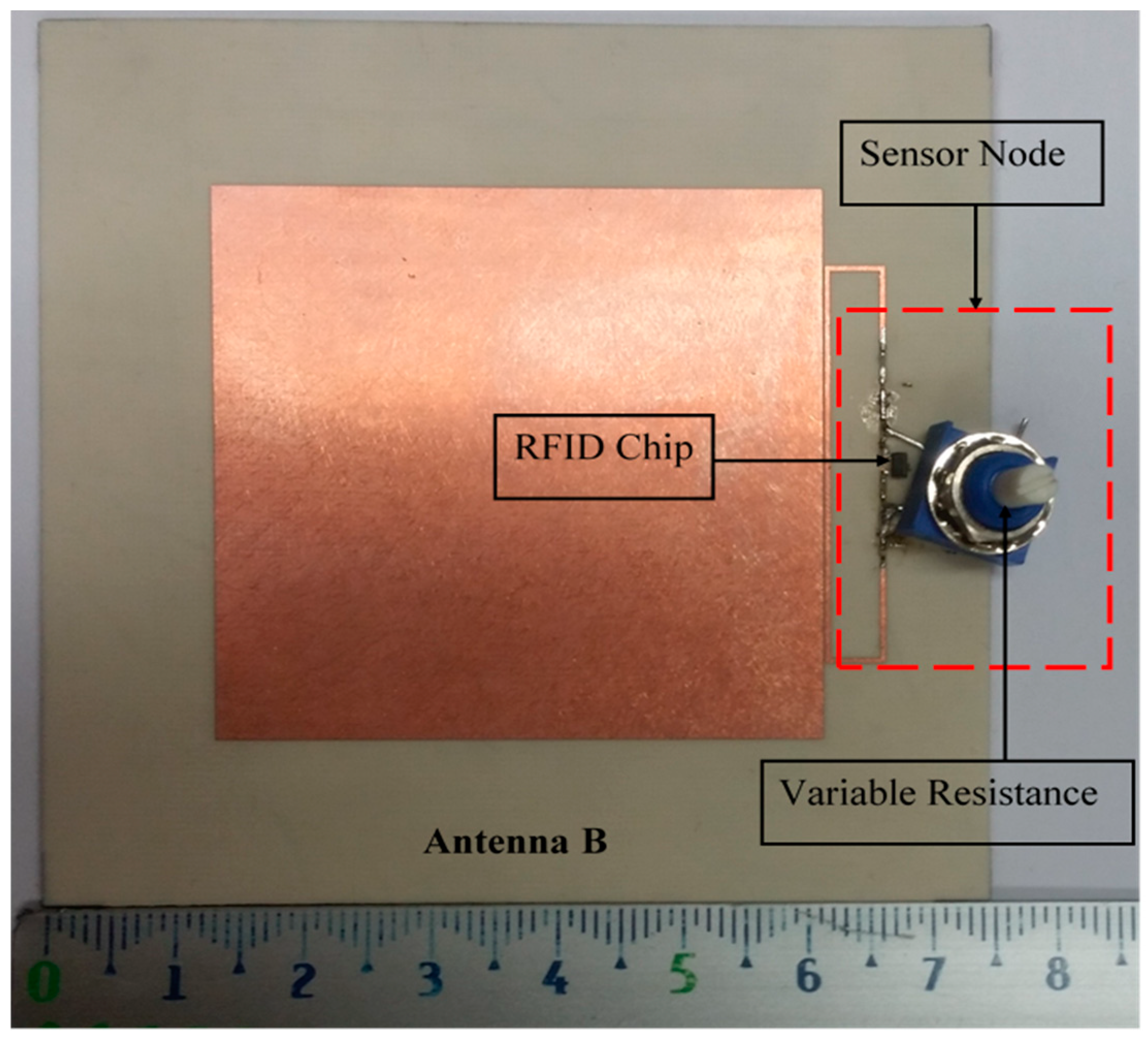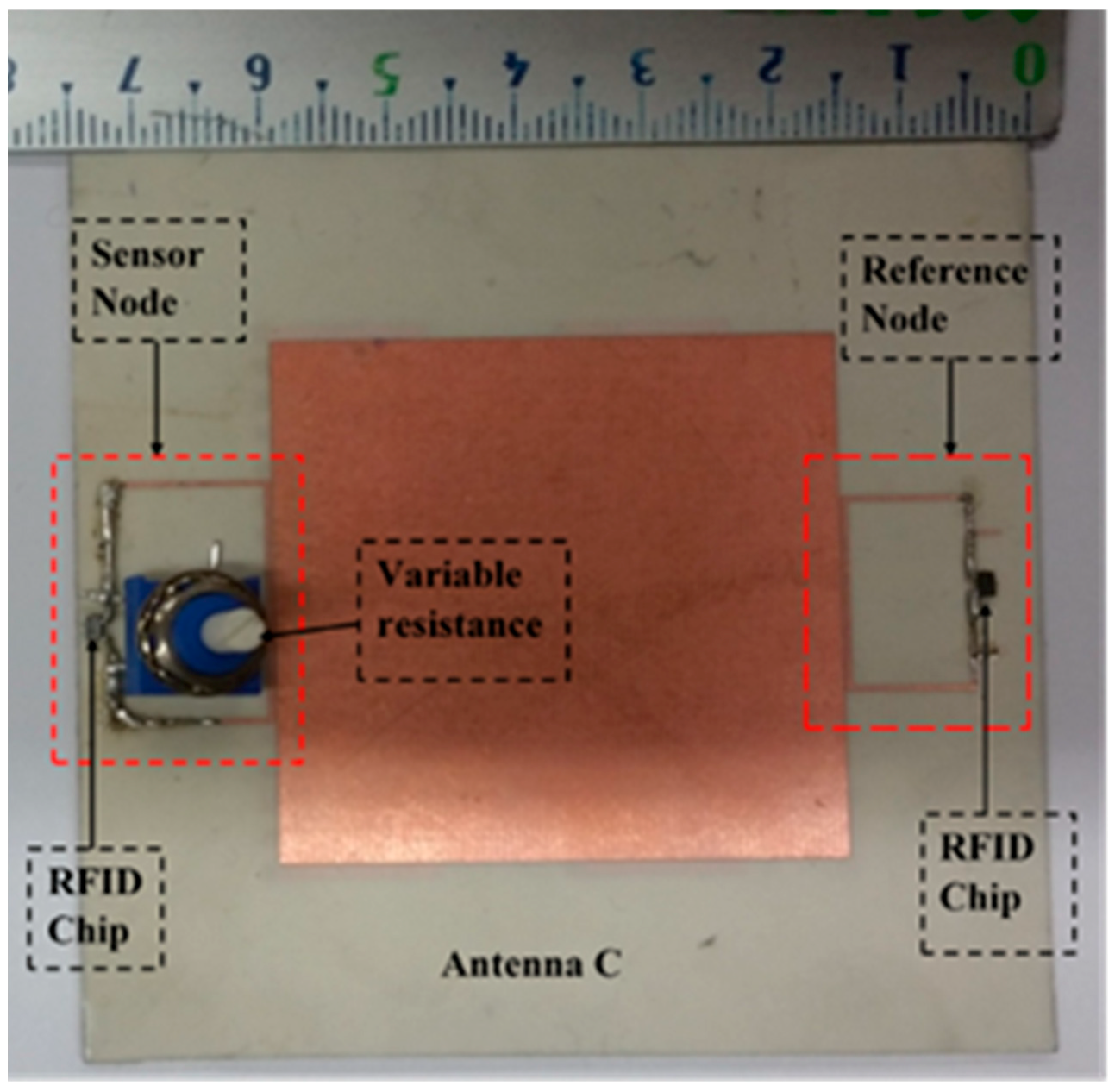Miniaturized Multi-Port Microstrip Patch Antenna Using Metamaterial for Passive UHF RFID-Tag Sensor Applications
Abstract
:1. Introduction
2. Proposed Unit Cell
3. Antenna Design
4. Single Port Antenna
5. Single Port Antenna-Based Sensor
6. Multi-Port Antenna-Based Sensor
7. Conclusions
Author Contributions
Conflicts of Interest
References
- Marrocco, G.; Mattioni, L.; Calabrese, C. Multiport sensor RFIDs for wireless passive sensing of objects—Basic theory and early results. IEEE Trans. Antennas Propag. 2008, 56, 2691–2702. [Google Scholar] [CrossRef]
- Babar, A.A.; Manzari, S.; Sydanheimo, L.; Elsherbeni, A.Z.; Ukkonen, L. Passive UHF RFID tag for heat sensing applications. IEEE Trans. Antennas Propag. 2012, 60, 4056–4064. [Google Scholar] [CrossRef]
- Gao, J.; Siden, J.; Nilsson, H.-E. Printed electromagnetic coupler with an embedded moisture sensor for ordinary passive RFID tags. IEEE Electron Device Lett. 2011, 32, 1767–1769. [Google Scholar] [CrossRef]
- Merenda, M.; Felini, C.; Corte, F. A Monolithic Multisensor Microchip with Complete On-Chip RF Front-End. Sensor 2018, 18, 110. [Google Scholar] [CrossRef] [PubMed]
- Sidén, J.; Zeng, X.; Unander, T.; Koptyug, A.; Nilsson, H.-E. Remote moisture sensing utilizing ordinary RFID tags. In Proceedings of the IEEE Sensors, Atlanta, GA, USA, 28–31 October 2007; pp. 308–311. [Google Scholar]
- Kim, S.; Kawahara, Y.; Georgiadis, A.; Collado, A.; Tentzeris, M.M. Low-cost inkjet-printed fully passive RFID tags for calibration-free capacitive/haptic sensor applications. IEEE Sens. J. 2015, 15, 3135–3145. [Google Scholar] [CrossRef]
- Gao, J.; Sidén, J.; Nilsson, H.-E.; Gulliksson, M. Printed humidity sensor with memory functionality for passive RFID tags. IEEE Sens. J. 2013, 13, 1824–1834. [Google Scholar] [CrossRef]
- Jiang, Z.; Yang, F. Reconfigurable RFID tag antenna for wireless temperature monitoring. In Proceedings of the 2012 IEEE International Symposium on Antennas and Propagation, Chicago, IL, USA, 8–14 July 2012; pp. 1–2. [Google Scholar]
- De Donno, D.; Catarinucci, L.; Tarricon, L. A Battery-Assisted Sensor-Enhanced RFID Tag Enabling Heterogeneous Wireless Sensor Networks. IEEE Sens. J. 2014, 14, 1048–1055. [Google Scholar] [CrossRef]
- Abdulhadi, A.E.; Belaizi, Y.; Vena, A.; Dindini, T.A. Miniaturized self-powered UHF RFID tag-based sensor. In Proceedings of the 2017 IEEE MTT-S International Microwave Symposium (IMS), Honololu, HI, USA, 4–9 June 2017; pp. 824–826. [Google Scholar]
- Abdulhadi, A.E.; Abhari, R. Design and experimental evaluation of miniaturized monopole UHF RFID tag antennas. IEEE Antennas Wirel. Propag. Lett. 2012, 11, 248–251. [Google Scholar] [CrossRef]
- Abdulhadi, A.E.; Abhari, R. Multiport UHF RFID-tag antenna for enhanced energy harvesting of self-powered wireless sensors. IEEE Trans. Ind. Inform. 2016, 12, 801–808. [Google Scholar] [CrossRef]
- Abdulhadi, A.E.; Denidni, T.A. Self-Powered Multi-Port UHF RFID Tag-Based-Sensor. IEEE J. Radio Freq. Identif. 2017, 1, 115–123. [Google Scholar] [CrossRef]
- Zaid, J.; Abdulhadi, A.; Kesavan, A.; Belaizi, Y.; Denidni, T. Multiport Circular Polarized RFID-Tag Antenna for UHF Sensor Applications. Sensor 2017, 17, 1576. [Google Scholar] [CrossRef] [PubMed]
- Balanis, C. Antenna Theory, Analysis, and Design, 2nd ed.; Wiley: New York, NY, USA, 1997. [Google Scholar]
- Mookiah, P.; Dandekar, K.R. Metamaterial-Substrate Antenna Array for MIMO Communication System. IEEE Trans. Antennas Propag. 2009, 57, 3283–3292. [Google Scholar] [CrossRef]
- Pinsakul, A.; Chaimool, S.; Akkaraekthalin, P. Miniaturized microstrip patch antenna printed on magneto-dielectic metasubstrate. In Proceedings of the 2012 9th International Conference on Electrical Engineering/Electronics, Computer, Telecommunications and Information Technology (ECTI-CON), Phetchaburi, Thailand, 16–18 May 2012; pp. 1–4. [Google Scholar]
- Shi, Y.; Li, Z.Y.; Li, K.; Li, L.M.; Liang, C.H. A Retrieval method of effective electromagnetic parameters for inhomogeneous metamaterials. IEEE Trans. Micow. Theory Tech. 2017, 65, 1160–1178. [Google Scholar] [CrossRef]
















© 2019 by the authors. Licensee MDPI, Basel, Switzerland. This article is an open access article distributed under the terms and conditions of the Creative Commons Attribution (CC BY) license (http://creativecommons.org/licenses/by/4.0/).
Share and Cite
Zaid, J.; E. Abdulhadi, A.; A. Denidni, T. Miniaturized Multi-Port Microstrip Patch Antenna Using Metamaterial for Passive UHF RFID-Tag Sensor Applications. Sensors 2019, 19, 1982. https://doi.org/10.3390/s19091982
Zaid J, E. Abdulhadi A, A. Denidni T. Miniaturized Multi-Port Microstrip Patch Antenna Using Metamaterial for Passive UHF RFID-Tag Sensor Applications. Sensors. 2019; 19(9):1982. https://doi.org/10.3390/s19091982
Chicago/Turabian StyleZaid, Jamal, Abdulhadi E. Abdulhadi, and Tayeb A. Denidni. 2019. "Miniaturized Multi-Port Microstrip Patch Antenna Using Metamaterial for Passive UHF RFID-Tag Sensor Applications" Sensors 19, no. 9: 1982. https://doi.org/10.3390/s19091982
APA StyleZaid, J., E. Abdulhadi, A., & A. Denidni, T. (2019). Miniaturized Multi-Port Microstrip Patch Antenna Using Metamaterial for Passive UHF RFID-Tag Sensor Applications. Sensors, 19(9), 1982. https://doi.org/10.3390/s19091982



